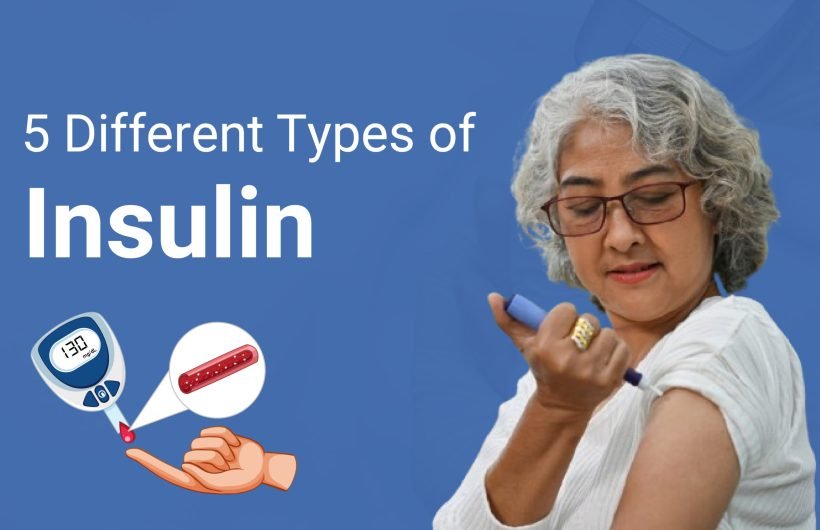Diabetes is a condition that affects how your body uses glucose, a sugar that’s vital for energy. Glucose is a type of sugar that is in the bloodstream and regulated by the hormone insulin which is manufactured in the pancreas. Those who have diabetes should take insulin particularly those with Type 1 diabetes or some cases of Type 2 diabetes.
Many different types of insulin can be taken and there are some different categories which depend on the needs of the patient. Fear not, in this article, we will explain with the help of Dr. Moxit Shah, what are the 5 types of insulin used in diabetes management.
1. Rapid-Acting Insulin
Fast-acting insulin has been synthesized to work more immediately, in many cases it takes fifteen minutes after an injection has been done. When taken it reaches its peak in the body after one to two hours and starts to wear off after 2-4 hours. This is given, based on the name as it is, before or after taking a meal because it assists in the moderation of the progression of hyperglycemia which is brought about by eating.
- Examples: there exist three categories of rapid-acting insulin insulin lispro, insulin and insulin glulisine.
- When to Use: Before meals or dinnertime but they also wake up at night to feed too.
- Key Point: Concurrently it works rapidly but lasts for a short time so it can be useful for regular compensation of blood sugar levels during eating.
2. Short-acting insulin
Also called regular insulin for diabetes it starts within 30 minutes of injection and reaches its maximum in 2-3 hrs and has an effect that lasts for about 6 hrs at most. It is normally used before meals, but not as emergency planning insulin as the rapid-acting.
- Examples: Humulin R, Novolin R.
- When to Use: Well, the signs include that food should be taken about 30 minutes before eating and forming their own beliefs about the food.
- Key Point: It is slow-acting and requires more time to show its effects than the rapid-acting insulin but the effects are long-lasting.
3. Intermediate-Acting Insulin
This type of insulin for diabetes covers your blood sugar needs for about half a day or overnight. It takes about 2-4 hours to start working, peaks at 4-12 hours, and lasts up to 18 hours.
- Examples: NPH (Neutral Protamine Hagedorn).
- When to Use: Usually, they are used in two separate doses to offer extended period control of blood sugar levels.
- Key Point: It takes a little while to work, the effects last longer and are therefore suitable to keep the blood sugar levels constant throughout the day.
4. Long-Acting Insulin
This insulin is active over a day releasing evenly in the bloodstream giving a fairly stable blood sugar level without spikes or dips. For this reason, it can be administered as a background or “basal” insulin to help with glucose regulation in between meals and during the night.
- Examples: Insulin glargine, insulin detemir, insulin degludec.
- When to Use: In most cases it is used once daily, preferably in the morning or before going to bed at night.
- Key Point: Provides consistent non-deteriorating blood sugar level regulation which means that patients with diabetes can use it to reduce the frequency of injections.
5. Pre-Mixed Insulin
Twin compositions come in a combination of two distinct types of insulin fast or short-acting insulin and intermediate-acting insulin. It helps in simplification of insulin injections, especially for those individuals who otherwise would have to keep on switching between different types of insulin injections during the day.
- Examples: Humalog Mix 75/25; Novolog Mix 70/30.
- When to Use: Usually it is used before eating food for effective digestion and assimilation of the nutrients or before undertaking other activities.
- Key Point: It is more appropriate since it offers both short-term and long-term regulation of the blood sugar level.
How to Choose the Right Type of Insulin
In general, decisions regarding the right type of insulin for diabetes include – personal lifestyle, blood sugar levels at that particular time, and how the body reacts to the insulin treatment. Dr Moxit Shah provides advice about choosing the right way of insulin therapy. It’s possible to require several types of insulin to manage glucose levels in your blood effectively.
Conclusion
It is very important to know the different types of insulin when dealing with diabetes disease. Regardless of whether you require bolus insulin for the rise in blood sugar levels during meals or basal insulin for longer and consistent control of blood sugar levels, there is always a way in every person.
According to Diabetes Specialist in Ahmedabad Dr. Moxit Shah, fluent contact between patients suffering from diabetes and their doctors has to be maintained, so that the dosage of insulin can be corrected, if necessary. With an understanding of the five types of insulin, one can effectively assume personal control of one’s life and command his/her diabetes to a much greater extent.







